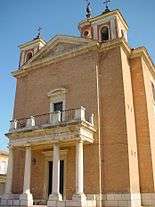Real Cortijo de San Isidro

The Real Cortijo de San Isidro[1] is a village that is administratively part of the municipality of Aranjuez, about 6 km south of the southern limit of the Community of Madrid, Spain. It has a voluntary, but official, village council known as 'una entidad local menor' that presides over an area of 1126 hectares. The Spanish State Statistical Survey of 2013 found 296 male and 306 female residents.
Etymology
The settlement was named after San Isidro the farm-worker, the patron saint of farmers.
History
Real Cortijo is notable because it was built as an experimental agricultural station in 1766 during the Enlightenment, which was inspired by King Carlos III, an enthusiastic physiocrat who was persuaded that the value of his kingdom lay more in its lands and people than in the gold and silver stored in its treasury.
After the death of Carlos III, the Cortijo fell into decay, as his son, Carlos IV, showed little interest in agriculture. In 1868, during the reign of Isabel II, the farm was sold off.
In 1944, after the civil war, the Spanish National Institute of Colonization sequestered the land. Previous owners and new settlers from various other provinces became tenants. The existing residential area was extended by the addition of newly built homes.
In the 1950s local land and houses were sold to individuals. A royal decree of September 1957 formally established the local council as a legal entity.[2] On the 15th of May, the saints-day of the patron San Isidro, a festival is celebrated which traditionally includes a lively sale of local farm and market-garden produce.
Facilities
It possesses a great house La Casa Grande, a winery known as La Real Bodega de Carlos III, and an associated wine cellar, La Cueva. In 1788, the year in which Carlos III died, a neo-classical Church, La Ermita del Real Cortijo de San Isidro en Aranjuez, was added.
References
- ↑ Real CortijoSan Isidro - official site (in Spanish)
- ↑ Spanish Government (19 September 1957). "Entidades locales menores.- Decretos por los que se autoriza su constitución a los pueblos Cortijo de San Isidro (Madrid), Rañín (Huesca), Valdivia (Badajoz) y San Isidro de Albatería (Alicante)." (PDF). Boletín Oficial del Estado de España nº 238.
External links
- wikivoyage:Aranjuez Wikimedia tourist guide project (English)
- Official homepage of Aranjuez City Council (Spanish)
- Official Tourist Agency website with comprehensive professional photographs of main attractions (Spanish)
Coordinates: 40°03′18″N 3°33′56″W / 40.0550°N 3.5656°W